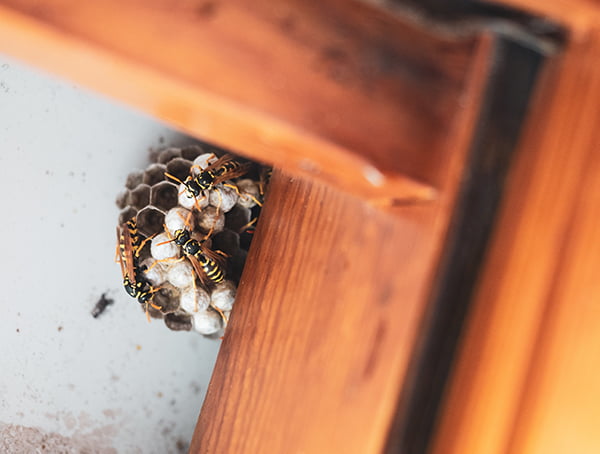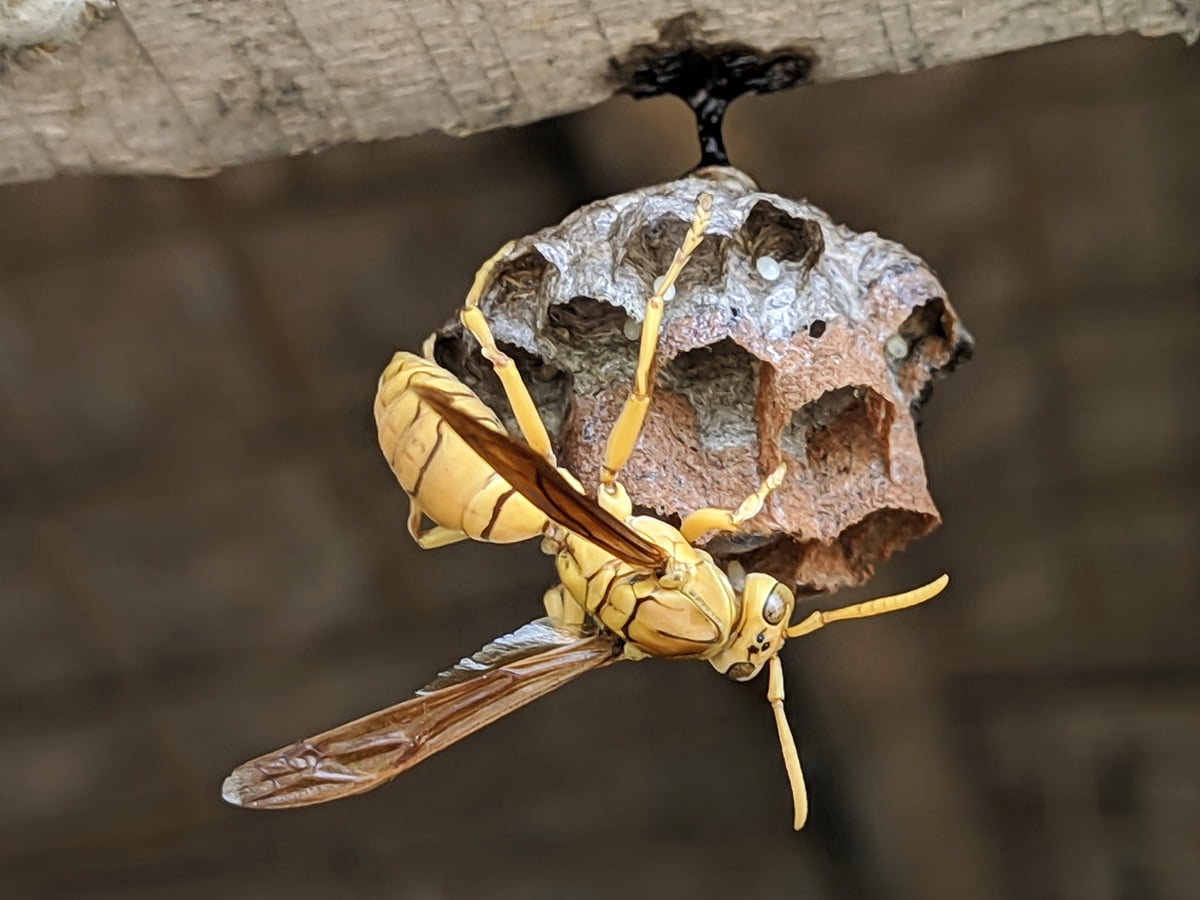Wasps and hornets may have a place in the larger ecosystem, but they're often aggressive, and stings can sometimes be deadly. There are many places around a home where queen wasps might take up residence, and getting rid of wasps is best. Below, we'll discuss how to prevent wasps and hornets from building a nest nearby in the first place and how to remove them if it does happen.
Different Types Of Wasp Species
Each type of wasp species behaves differently and has different nesting habits. To deter or remove wasps, it's beneficial to identify what kind of wasp or hornet you're dealing with!
Yellow Jackets
Yellow jackets are wasps with prominent yellow and black markings and are about the size of a bee. They have thick bodies compared to other types of wasps. They are aggressive wasps, particularly in late summer, and yellow jacket stings are particularly painful. Yellow jackets build nests in two areas - on the ground and aerial. Both types are large and are enclosed in a thick papery shell. In-ground nests are often found in old gopher holes. Aerial nests are large, pretty easy to spot, and often hang from tree branches.
Paper Wasps
Paper wasps are longer than yellow jackets, at about an inch long. There are different types of paper wasps, but they all are brown or black, with yellow or red markings. They build small nests consisting of a single comb layer used for raising eggs and larvae. These open and exposed nests are frequently found under overhanging roof eaves or inside garden sheds and look like an upside-down umbrella. Paper wasps won't sting unless they feel threatened.
Mud Daubers
Mud daubers have a distinct body shape, with a long thin taper to their abdomen. They are solitary wasps, considerably docile, and are very effective and killing other insects, such as spiders! They can generally be left alone. Mud daubers use mud to build rows of long tubes in which to lay their eggs. Being a solitary species, the nests only need to serve themselves and their offspring and don't get very big. The nests usually cling to existing cracks and crevices in the stonework.
Hornets
Hornets, while not exactly wasps are closely related to them. There are 20 species of hornets, and most of them are black with very distinct yellow or white stripes. They build large aerial nests with a thick papery covering, similar to yellow jackets. European hornets build their nests in tree stumps and other natural cavities. Hornets are a very social species and will swarm if they feel threatened.
Bees Versus Wasps
Bees and wasps are similar - they both make nests, sting, and pollinate. However, bees are more active pollinators and have been more detrimentally affected by many modern lawn care practices. It's important not to kill bees and keep their hives on your property, if possible. They are much less aggressive than wasps since they die after stinging.

Image Source: Unsplash
Why Do I Have Wasps In My Yard?
Wasps are naturally going to buzz through every person's yard, but they might choose to take up residence there for two reasons:
Shelter
You likely have an ideal location for a wasp nest somewhere on your property. The mortar space between bricks is ideal for mud daubers to build their tubular mud chutes. Any overhanging eave will attract paper wasps. Stacks of firewood and gopher holes are perfect for in-ground wasp nests.
Food
Wasps can utilize many types of food sources. Digger wasps will eat grubs and other insects that live near the soil's surface. Scraps and grease drippings around a grill are the perfect food for protein-loving wasps. In the fall, their diet shifts to include more sugar before the temperature dips, so fallen fruit and hummingbird feeders can attract them. They also are attracted to flowering plants as pollinators.

Imagine Source: Unsplash
How To Prevent Wasps From Building Nests
If you notice wasps nearby and want to deter wasps from building a nest, there are a few things you can do:
Apply Insecticide
You can find residual liquid insecticides at many hardware stores. Spray it in locations that would be prime real estate for a wasp nest, such as on and under decks and patios, on playsets, in garden sheds, under eaves, and along wooden fences.
Hang Wasp Traps
These traps use a liquid that attracts wasps inside but prevents them from getting back out. You can purchase them or make your own using a two-liter soda bottle, fruit juice, and dish soap.
Check For Crevices
Wasps sometimes make it inside your house, which must be prevented. Check your house for gaps, cracks, wall voids, and other entry points. Use caulk to seal up these access points.
How To Get Rid Of Wasp Nests
In the spring, a queen wasp starts to build a nest. These start at a walnut or golf ball size, but wasps build nests quickly. Summertime nests can contain thousands of wasps, so removing any wasp nest earlier rather than later is best. Here's how:
- Wait Until Evening - Wasps are out of their nest looking for food during the day, typically returning in the early evening hours. If you attack or remove the wasp nest during the day, the wasps will just return and start new nests.
- Use A Wasp Spray - Wasp sprays kill wasps instantly. Purchase a spray that allows you to spray from a distance and thoroughly coat the wasp's nest. The wasp spray kills the adult wasps in the nest and any larvae in the comb. It also will poison the sides of the nest.
- Wait And Repeat - Large wasp colonies will often have scout wasps out that may take a day or two to return. After spraying a wasp nest with spray, wait a full 48 hours so that those scout wasps have time to return and die. You may need to repeat the spraying process.
- Remove The Nest - The final step is wasp nest removal. All of the wasp activities should be done, but just in case, wear thick gloves to protect against wasp stings. Use a garbage bag to cover the nest and remove it from the tree or wall. Seal the bag tightly.
If you'd prefer to avoid the strong chemicals of a wasp spray, you can make your own spray using dish soap and water. This solution will clog the wasp's breathing pores and kill them. However, this homemade solution will take longer to get rid of an entire wasp or hornet nest.

